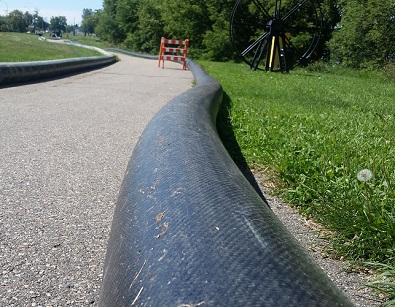A water pipeline snakes its way from Little Red River towards Prince Albert’s water treatment plan. Photo by Chelsea Laskowski
Some primary shoreline raking is complete near the Maidstone site of the Husky Energy oil spill, according to the latest update from the province on recovery efforts.
Boats are out on the North Saskatchewan River, and as of right now more than 600 people are responding to a pipeline failure that saw more than 250,000 litres of Husky Energy’s oil spill into the water.
Since Tuesday, the province’s collection of water samples have jumped significantly. It’s adding 260 more water samples to make for a total of more than a thousand samples since July 21.
Kevin McCullum with the Ministry of Environment explained what’s going on at this moment near the spill site.
“We’re working on preliminary cleanup of soil and vegetation removal that will continue. Manual shoreline cleanup with rakes and shovels has been completed in the most heavily impacted areas, from tge point of entry to about kilometre six and will continue,” he said.
“Material actually goes into a waste plan so all of the material is collected and eventually the oil is analyzed, it can be extracted off the material and that’s part of the whole assessment as we go forward. But it is all collected and removed off site.”
North Battleford, Prince Albert and Melfort all typically rely on the North Saskatchewan River for drinking water. The past week or so has been full of hard work in all communities.
North Battleford is disinfecting its water line from the town of Battleford, and that will take 24 hours. Once that’s done they’ll still need 24 hours to get water to be tested to ensure its safe.
That means by Sunday or Monday, that water should be good to go.
Prince Albert’s reservoirs are almost full right now and has announced a rollout for removing water restrictions.
Meanwhile, the Ministry of Economy continues to assert that although physical inspections of the pipeline that failed haven’t occurred, there are other ways of monitoring pipelines that have been followed – this includes electronic monitoring.
The provincial auditor will have a review ready this fall related to whether the province has followed her recommendations related to oil pipeline safety.
Previously, the province had only completed two of seven recommendations that were first made in 2012. The 2012 report stated that the Ministry of Energy and Resources did not have effective ways to ensure full compliance with laws for pipeline construction and operation.
